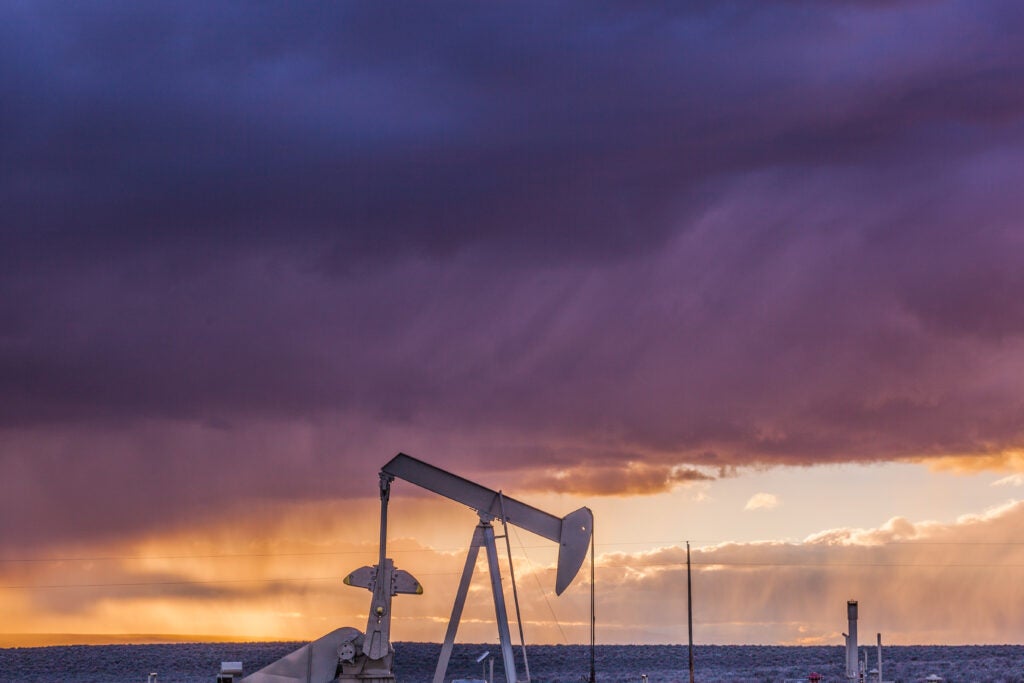Study shows small sources account for large share of oil & gas methane emissions, underscores importance of key federal initiatives
For a dozen years, study after scientific study has documented the vast amount of methane released to the atmosphere by oil and gas operations worldwide. Faced with mounting data, both producers and regulators have slowly but steadily ramped up efforts to cut these emissions, which are both a waste of natural resources and a powerful climate pollutant.
Until now, emphasis has largely been on chasing down large emissions sources, sometimes called super-emitters. After all, why not go after the biggest fish first? What’s more, big leaks are easier to find. But a new study led by EDF scientists builds an integrated analysis of measurement-based data spanning a range of emitting facilities across multiple US oil and gas basins calls this assumption into question.
Published in the journal Atmospheric Chemistry and Physics, the research finds that 70% of the roughly 15 million metric tons of methane from onshore oil and gas activities in the continental US comes from smaller, dispersed sources emitting less than 100 kilograms of methane per hour, and that fully 30% of the total comes from sites releasing less than 10 kilograms per hour.
(You can find more details here, in a blog by two of the study authors.)
The share is even higher in many of the highest-emitting regions: Roughly 80% of methane emissions in the Permian, Appalachian and Eagle Ford basins come from smaller sources. In the San Joaquin, it’s nearly 90%. Even in the Anadarko and Bakken basins, which fall below the national average, smaller sources account for about 60% of total oil and gas methane.
Study shows small sources account for large share of oil & gas methane emissions, underscores importance of key federal initiatives Share on XAuthors say the total estimated emissions across all lower-48 US basins amount to a loss rate of 2.4% (normalized to gross gas production). That’s more than double the loss rate EPA Greenhouse Gas Inventory Report for natural gas and petroleum systems in 2021.
Houston, we have a problem — one with important implications for methane policymakers.
Analyzing emission characteristics from nearly 700,000 sites of various types of facilities, the study shows production wells are responsible for the overwhelming share of total emissions. Of those emissions, between 67 and 90% come from older, low-producing wells collectively accounting for just 10% of total production. We’ve seen similarly wild disproportions in other studies.
Around the country (and the world), aging wells remain in operation even as their output invariably tapers off. As years go by, their emissions continue unabated. Best estimates are there are at least half a million scattered across the US alone.
The new findings underscore the disproportionate impact that smaller sources have on the oil and gas industry’s total methane emissions, and just how important it is to fund solutions to clean them up.
Congress allocated crucial funding to ensure that owners of these wells have access to cost-effective solutions to find and fix methane leaks. Created under the 2022 Inflation Reduction Act, the Methane Emissions Reduction Program will give operators better technology and more options to reduce methane pollution by keeping valuable methane (natural gas) in the pipes.
The funding is one piece of a three-part strategy that also includes methane performance standards for both new and existing facilities, and a waste emissions charge for companies that exceed those standards. MERP is meant to help operators hit their targets and avoid the fee. So far, the Department of Energy and the Environmental Protection Agency have issued hundreds of millions of dollars to support a variety of new technologies going straight to the aging, marginal wells.
Oil and gas producers across the country have been broadly supportive of MERP, welcoming the program as a valuable way to ease the cost of reducing emissions from aging, often under-capitalized wells and increase competitiveness in global LNG markets.
The good news is, new satellites can help. For example, MethaneSAT, developed by an EDF subsidiary with support from the Bezos Earth Fund and other donors and launched in March 2024, is specifically designed to quantify total regional emissions — capturing emissions from these smaller sources that often go undetected.
This data can help improve the accuracy and specificity of emissions inventories, can serve as the basis for innovative and more precisely targeted policy design, and can provide invaluable information to gas importers and commercial buyers interested in accounting for emissions associated with their natural gas supply chains.
Unfortunately, MERP’s future is in question under the Trump administration, along with a host of other cost-effective efforts to reduce methane pollution. Axing these programs would undo a crucial opportunity to help slow the dangerous rate at which the Earth is warming and improve both energy security and price stability domestically and abroad.
Tackling methane is one of the best climate solutions we have, and efforts like MERP that use technology to target key sources are better still. Here’s hoping that the leadership will see their way clear to let this successful program continue.












